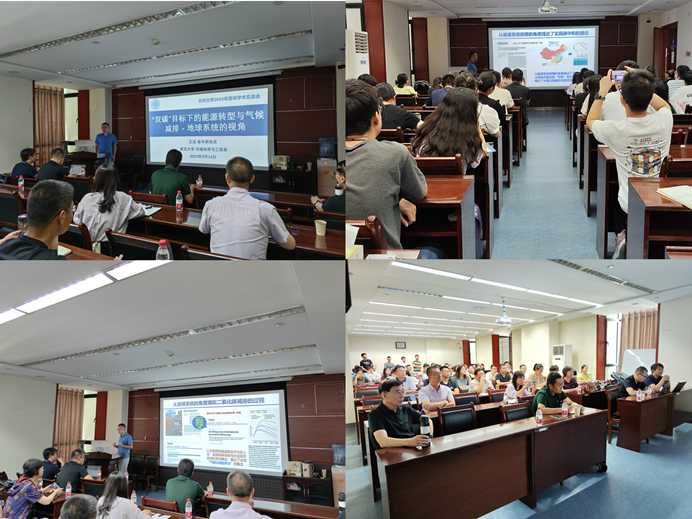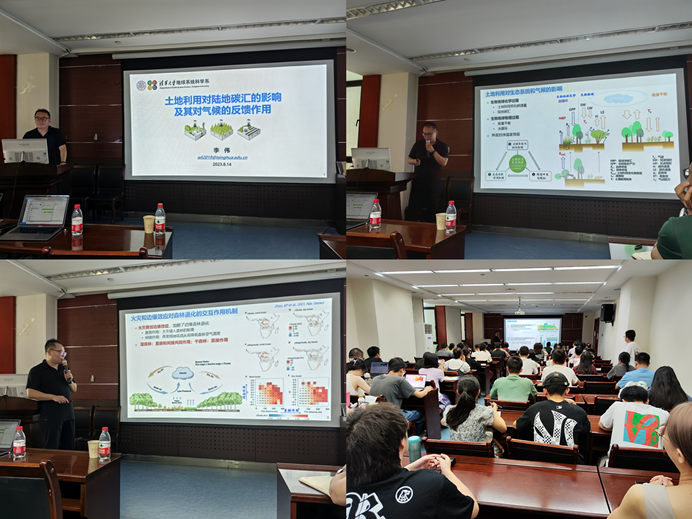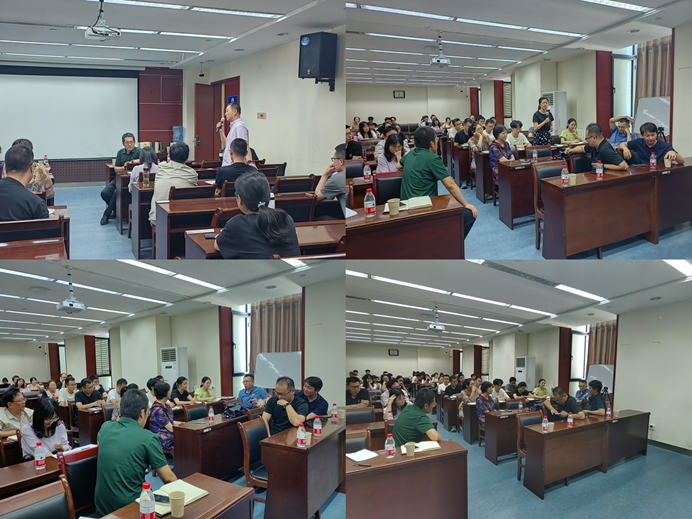at the invitation of professor huang tao from the college of earth and environmental sciences and the key laboratory of environmental pollution warning and control in gansu province, young researcher wang rong from the department of environmental science and engineering at fudan university, associate professor li wei from the department of earth system science at tsinghua university, and researcher dai hancheng from the college of environmental science and engineering at peking university visited our university on august 14 for academic exchange. they each delivered academic presentations titled "transitioning energy systems and climate mitigation under dual carbon goals - a perspective from earth systems," "impacts of land use on terrestrial carbon sinks and their climate feedback," and "complex system modeling and multi-dimensional impact assessment of climate and environmental policies." the lectures were chaired by professor huang tao from the college of earth and environmental sciences, and faculty members and students from the college of earth and environmental sciences and the school of atmospheric sciences attended the presentations.

in his lecture, young researcher wang rong explored the feedback mechanisms between climate change and emission reduction technologies and the optimal pathways for achieving carbon neutrality. he emphasized that addressing global climate change and implementing emission reduction strategies are crucial international issues. among various negative emission technologies, bioenergy with carbon capture and storage (beccs) is considered the most cost-effective option. however, due to climate change impacts, the biomass supply for beccs may decrease, hindering its efficacy in achieving the paris agreement's 2°c target by 2200. wang's team introduced beccs-based negative emission technologies into an earth system model, established a global socio-economic dataset, and evaluated the utility of large-scale beccs implementation from 2030 to 2100 based on shared socio-economic pathways. the study revealed that the feedback effects of negative emission technologies significantly influence long-term climate trends. initiating large-scale beccs efforts after 2050 could result in surpassing critical climate thresholds, making it challenging to achieve the paris agreement's temperature target. the study emphasized the need for comprehensive assessments considering energy, food, and land interactions in future climate evaluations.

associate professor li wei highlighted that land use changes are integral to the global carbon cycle, with forests playing a pivotal role in terrestrial carbon sinks while influencing surface energy balance. forest degradation contributes to carbon emissions, exacerbating global warming through biogeochemical and biophysical effects. li's lecture delved into tropical forest degradation and land-based carbon sequestration potentials. he presented the impacts of forest degradation in tropical regions due to factors like fire and edge effects, highlighting their contribution to both biophysical and biogeochemical warming effects. moreover, his team estimated the net carbon removal capacity of different bioenergy crop scenarios through processes like biomass harvesting, carbon capture, and land use changes. earth system modeling simulated the feedback effects of bioenergy crop cultivation on climate through biophysical mechanisms. the research provided insights into the significance of large-scale bioenergy crop cultivation's biophysical effects for future climate change mitigation policies.

researcher dai hancheng underscored the urgency of achieving carbon neutrality and discussed the necessity of swift and deep carbon reduction. he elaborated on the current status and trends in domestic and international model studies and stressed the importance of localized, refined integrated assessment models (iams) for achieving china's dual carbon goals. dai emphasized that pollution reduction and carbon mitigation policies should consider socio-economic aspects. to address complex policy challenges, a more nuanced approach is needed to analyze driving factors' effects on energy emissions, incorporating factors like carbon intensity, energy service intensity, and energy efficiency. dai's team developed the imed environmental-economic model, encompassing energy economics, atmospheric quality, and public health modules. imed enables comprehensive simulations of multi-factorial systems, assessing policy synergies and cost-effectiveness, and evaluating pollution and climate policies' impacts on economic growth, employment, and sectoral outputs. imed's representation of china's pollution and carbon reduction assessment enhances policy evaluation quality. case studies on achieving carbon neutrality in industries like steel and cement, along with carbon emissions-water resource coupling research, highlighted imed's evolving role in analyzing pollution reduction and carbon mitigation mechanisms.

during the discussion session, attendees engaged with the speakers on topics such as photovoltaic and wind power potential under china's climate goals, the influence of upgraded ultra-high voltage transmission on photovoltaic and wind energy costs, land use changes and carbon emissions, land ecosystem simulations, multi-environmental element coupling modeling, carbon reduction potential exploration, and integrating diverse modeling approaches. the interactive discussions were lively and the presentations broadened participants' knowledge and perspectives in dual carbon research